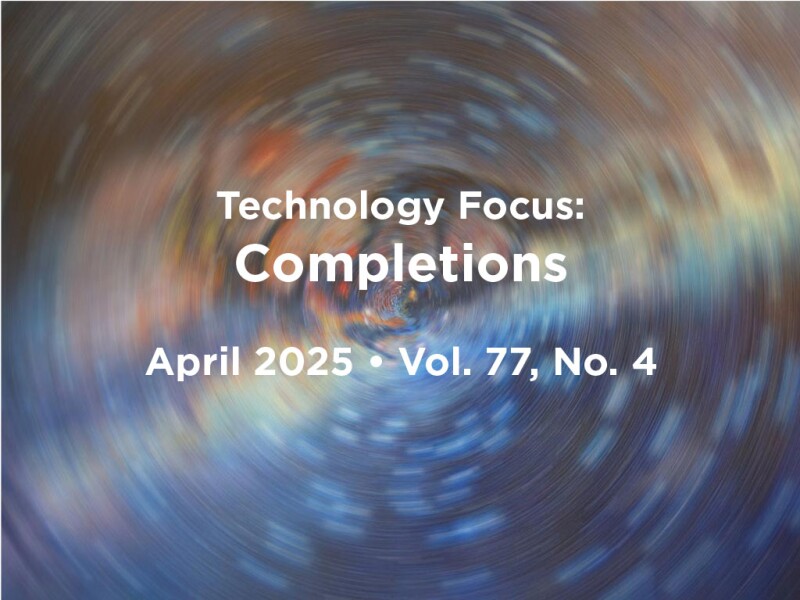For several years now, the energy industry has been actively working on solutions and technologies to support sustainability aspirations. Whether for a company or a country, most efforts were put into alternative or renewable energy research and development and in reducing flaring and venting intensity. While the industry has shown great progress in these areas, there are still many areas that could contribute to sustainability aspirations, one of them being well completions.
It is refreshing to see now that sustainability is taken as an important element in developing completion technologies. These technologies affect the environment on different levels. Solutions can be as simple as technologies that reduce rig time and lessen diesel consumption, but they also have evolved toward full electrification of well completion design and surface facilities.
A great example of how well completion technologies can evolve can be found in paper OTC 35379. A full-scale electrification of a completion concept was well thought through, covering enhancement on reservoir management, development of multizonal wells with more precision, overall well-delivery optimization, life-of-field management, and how all these contribute toward lower CO2 emissions. The concept is meant not only for conventional field development but also for carbon capture and sequestration projects. A full end-to-end design concept such as this will move the needle in managing greenhouse-gas (GHG) emissions.
The extent of completion technology evolution does not stop with hardware and well design. Paper SPE 219258 pushes the limit by transitioning from conventional perforation methods into using high-powered lasers (HPL). Although it seems a just small facet of completions, perforation with HPL has positively affected GHG emissions, asset integrity, water consumption, surface footprint, operational logistics, and safety.
There is also a good balance between the long-term and near-term focus on sustainability. Technologies such as HPL and ideas such as full-scale electrification take a considerable amount of time to develop, but paper OTC 34885 is about what can be done now. Focusing on completion operation optimization, the authors found that designing and challenging the status quo of the double-barrier requirement during operations resulted in qualifying a modified tubing hanger design as a certified double-barrier plug. This has led to interventionless completions, thus reducing rig-operation time and eventually reducing diesel consumption and carbon emissions.
What really amazes me in these developments in the completions discipline is the fact that the solutions are coming from different parts of the world—from Brazil to Saudi Arabia to Malaysia. With such a global sustainability focus, the effect that completions technologies have on achieving the UN’s Sustainable Development Goals will be more evident in the near term.
Summarized Papers in This April 2025 Issue
SPE 219258 High-Power Laser Perforating Aligns Upstream Operations With Sustainable Technology by S. Alghamdi, Saudi Aramco, et al.
OTC 35379 Well-Completions Electrification Supports Sustainable Field Development by M. Le Menach, TotalEnergies, et al.
OTC 34885 Cost-Effective Bidirectional Barrier Technology Improves Interventionless Applications by A.M. Abu Bakar, Petronas, et al.
Recommended Additional Reading
IPTC 24032 Fiber Monitoring of TRSSV To Monitor Health and Forecast Failures by E. Murdoch, Saudi Aramco, et al.
SPE/IADC 219653 Carbon Capture Storage Drilling and Completion Well-Integrity Life-Cycle Challenges and Mitigations by Mahesh S. Picha, Consultant
IPTC 23423 Demonstration of a Remotely Set Liner Hanger Setting System Utilizing Acoustic Telemetry by A. Hawthorn, Baker Hughes, et al.

Shahril Mokhtar, SPE, is the general manager for Petronas Upstream Technology and Innovation. He is responsible for the strategic deployment of technology and innovation portfolio. Mokhtar has 25 years of experience in completions and well intervention. He holds a bachelor of engineering (honors) degree in mechanical and aeronautical design from the University of Brighton. He also holds a certificate in petroleum engineering and reservoir fundamentals from the University of Tulsa and has completed the Strategic Growth Leadership Program at Columbia Business School. Mokhtar earned Professional Technologists accreditation from the Malaysia Board of Technologists in 2020 and is an associate member of the Institution of Mechanical Engineers, UK. Mokhtar is the chairman for the SPE Asia Pacific Regional Technical Advisory Committee, receiving the SPE Regional Asia Pacific Technical Award in 2024 in Data Science and Engineering Analytics. He serves on an industry advisory panel at the University Technology Malaysia and as an expert in digitalization, data analytics, and automation for University Technology Petronas.

